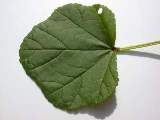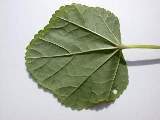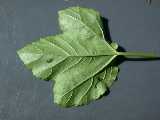 Malope 'Vulcan'
Malope 'Vulcan'
back to The Malope Page
back to Digital Herbarium
More Images
Distribution:
A tetraploid variety of Malope trifida of horticultural origin.
Habitat
Gardens.
Identification:
Malope trifida is superficially similar to the Rose Mallow, Lavatera trimestris, but differs from it in multiple characteristics, including glabrous stems, large, free, cordate, orbiculate bracteoles, keeled sepals, petals with rounded (not emarginate) apices, and placement of the stamens in 5 parallel zones, rather than completely surrounding the column. These characteristics also serve to distinguish it from other species of Malva and Lavatera.
More generally the globose schizocarp distinguishes Malope from all other European mallows, other than Kitaibelia. It can be distinguished from Kitaibelia by the epicalyx consisting of 3, rather than 6-9 segments. The shape of the epicalyx segments is also distinctive.
'Vulcan' has darker and smaller flowers than the red form of Malope trifida 'Glacier Fruits'.
Source:
Commercial seed (Suttons).
Technical Description
Erect, branched, annual herb, to 100 cm, stipules, bracteoles and sepals ciliate, petioles sparsely hispid, otherwise glabrous. Stems green, becoming red at the base; foliage alternate, stipulate and long-petiolate; stipules ciliate, lanceolate-ovate, 10 mm long; leaf axils purplish; petioles, green, often suffused with purple, sometimes sparsely hispid distally, up to 11 cm long; laminae simple, cordate, reniform to orbicular, crenate, up to 13 cm wide × 10 cm long, with a purplish spot at the junction of petiole and blade, the lower leaves palmately 5-nerved, obscurely and obtusely lobed, upper leaves 3-nerved, more distinctly and sharply lobed; inflorescence indeterminate, an initially corymbose leafy raceme; flowers hermaphrodite, protandrous, long-pedicellate, involucellate, borne ascending, singly, in the axils of upper leaves and of leaves of side shoots; pedicels long, to 14 cm, longer than subtending petiole; bracteoles 3, free, cordate, broadly ovate, acute, ciliate, otherwise glabrous, 20 mm long at anthesis increasing to 30 mm in fruit, marcescent; calyx valvate in aestivation, sepals 5, connate for about half their length, broadly lanceolate to ovate, 25 mm long, ciliate, keeled, keel with a single row of ciliate hairs, acuminate, marcescent; corolla convolute in aestivation, trumpet-shaped, about 7 cm across, petals 5, spirally arranged, hypogynous, asymmetrically obovate, adnate at the base to the staminal column, apex rounded (not emarginate), 4.5 cm long, deep crimson (RHS colour 67A) (base deep bluish-purple), becoming slightly paler towards the apex, with about 9 darker veins; staminal column reddish-purple (base deep bluish-purple), about 15 mm long, antheriferous for most of its length; stamens numerous, filaments deep-rose, borne in 5 radial zones; anthers dull pink, unilocular, bisporangiate; ovary white, ovary locules many, arranged in a capitate head, locules uniovulate, ovules ascending, placentation axile; style white, style branches purple, filiform, circa 50, as many as the locules, stigmas introrsely decurrent; fruit schizocarpous, globose; mericarps many, brown, rounded, striate, indehiscent, tardily separating when mature from each other and the receptacle.
Description
M. 'Vulcan' is an erect, branched, annual herb, growing to 3 or more feet in height. The stems are hairless. They are mostly green, but become red at the base, and also have purplish areas in the leaf axils. |
 |
|
The leaves are borne alternately (one per node), subtended by two stipules. The stalks are long, up to 4½". They are green, but are often suffused with purple. Sparse hairs sometimes occur near to the blade. The blades are cordate at the base. Those of the lower leaves are rounded, palmately 5-nerved, slightly lobed, and crenate. They range up to 13 cm wide by 10 cm long, but later leaves are often markedly smaller. The upper leaves are 3-nerved, more distinctly and sharply lobed. There is a purplish spot at the junction of the stalk and blade. |
  |
  |
The stipules are ovate-lanceolate with a tapering apex. They are about 10 mm in length, and have a sparse fringe of ciliate hairs (about 0.5mm long). They lie approximately in the plane of the blade and petiole of the leaf. |
 |
 |
The trumpet-shaped flowers are about 3" across. They are a deep satiny crimson (RHS colour chart 67A) becoming slightly paler towards their edges. They are composed of an epicalyx of 3 free bracteoles, a calyx of 5 fused sepals, and corolla of 5 free petals, and androecium of numerous fused monadelphous stamens, and a gynoecium composed of a single ovary and style with numerous style branches and stigmas. They are borne singly, in the leaf axils. They are held roughly upright. |
 |
|
The stalk is long (longer than the subtending leaf stalk), being up to 4½" in length. The bracteoles are broadly ovate, heart-shaped at the base, and pointed at the apex. They have sparse short hairs along their margins, and are otherwise hairless. They are about ¾" long when flowering, increasing to 1¼" in fruit. The dried bracteoles are retained around the seed head. |
 |
|
The sepals are about 1" long, broadly lanceolate to ovate, and connate for about half their length. They have a distinct keel along the midrib. Hairs are borne along the margins and the keel; the sepals are otherwise hairless. The dried calyx is retained around the seed head. |
 |
|
The petals are obovate. There are arranged in a spiral. The apex is rounded (contrasting to the notched or truncate apices found in many mallows). They are about 1¾" long. They are a deep satiny crimson (RHS colour chart 67A) becoming slightly paler towards the apex, with about 9 darker veins. The extreme base, and the base of the staminal column, is a deep bluish-purple. |
 |
|
The staminal column is reddish-purple. It is about 15 mm long and bears anthers for most of its length. The anther filaments are deep-rose and are borne in 5 radial zones. The anthers are dull pink.
|
 |
|
|
 |
|
The mericarps are dark brown, reniform, rounded, and striated. The contain a single seed. |
 |
|
Cultivation
Malope 'Vulcan' is grown from seed. This may be sown indoors, in late winter or early spring, at 20-30°C on the surface a free draining, damp seed compost. The seeds should be covered by a 1 mm layer of compost or vermiculite. The compost should be kept moist until germination, either by the container being placed within a propagator, or sealed with cling film or within a polythene bag. Germination typically takes one to two weeks.
When the seedlings are large enough to handle they should be transplanted into individual pots, and grown on in cooler, well lit, conditions. Acclimatise to outdoor conditions before planting out when there is not risk of frost.
Alternatively the seed may be sown in the flowering position in late spring.
Pests and Diseases:
Malope 'Vulcan', in common with many mallows, is susceptible to Hollyhock Rust, Puccinia malveae.
Cytology:
Malope 'Vulcan' is a tetraploid with a chromosome count of 88.
Variation
Short, simple, hairs have been observed at the distal end of some leaves. This has since been observed not to be universal. It has not been ascertained whether this represents variation between individuals, or whether the hairs are characteristic of young plants.
Taxonomy:
Malope 'Vulcan'
Malope 'Vulcan' is a tetraploid cultivar derived from Malope trifida Cav. As its tetraploid nature probably makes it reproductively isolated from Malope trifida (any hybrids between 'Vulcan' and the wild type, or other cultivars, would be expected to be triploid and sterile) I prefer not to include it in its parent species. To the best of my knowledge no species name has been erected for this strain.
Synonyms:
References
back to The Malope Page
back to Digital Herbarium
More Images
Acknowledgements
photographs © 2002, 2003 Stewart Robert Hinsley
text and HTML © 2003 Stewart Robert Hinsley